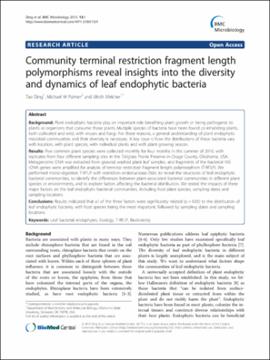| dc.contributor.author | Ding, Tao | |
| dc.contributor.author | Palmer, M. W. | |
| dc.contributor.author | Melcher, Ulrich | |
| dc.date.accessioned | 2019-08-21T22:01:37Z | |
| dc.date.available | 2019-08-21T22:01:37Z | |
| dc.date.issued | 2013-01-03 | |
| dc.identifier | oksd_ding_communitytermin_2013 | |
| dc.identifier.citation | Ding, T., Palmer, M. W., & Melcher, U. K. (2013). Community terminal restriction fragment length polymorphisms reveal insights into the diversity and dynamics of leaf endophytic bacteria. BMC Microbiology, 13(1). https://doi.org/10.1186/1471-2180-13-1 | |
| dc.identifier.uri | https://hdl.handle.net/11244/321217 | |
| dc.description.abstract | Background: Plant endophytic bacteria play an important role benefiting plant growth or being pathogenic to plants or organisms that consume those plants. Multiple species of bacteria have been found co-inhabiting plants, both cultivated and wild, with viruses and fungi. For these reasons, a general understanding of plant endophytic microbial communities and their diversity is necessary. A key issue is how the distributions of these bacteria vary with location, with plant species, with individual plants and with plant growing season. | |
| dc.description.abstract | Results: Five common plant species were collected monthly for four months in the summer of 2010, with replicates from four different sampling sites in the Tallgrass Prairie Preserve in Osage County, Oklahoma, USA. Metagenomic DNA was extracted from ground, washed plant leaf samples, and fragments of the bacterial 16S rDNA genes were amplified for analysis of terminal restriction fragment length polymorphism (T-RFLP). We performed mono-digestion T-RFLP with restriction endonuclease DdeI, to reveal the structures of leaf endophytic bacterial communities, to identify the differences between plant-associated bacterial communities in different plant species or environments, and to explore factors affecting the bacterial distribution. We tested the impacts of three major factors on the leaf endophytic bacterial communities, including host plant species, sampling dates and sampling locations. | |
| dc.description.abstract | Conclusions: Results indicated that all of the three factors were significantly related (α = 0.05) to the distribution of leaf endophytic bacteria, with host species being the most important, followed by sampling dates and sampling locations. | |
| dc.format | application/pdf | |
| dc.language | en_US | |
| dc.publisher | BioMed Central | |
| dc.rights | This material has been previously published. In the Oklahoma State University Library's institutional repository this version is made available through the open access principles and the terms of agreement/consent between the author(s) and the publisher. The permission policy on the use, reproduction or distribution of the material falls under fair use for educational, scholarship, and research purposes. Contact Digital Resources and Discovery Services at lib-dls@okstate.edu or 405-744-9161 for further information. | |
| dc.title | Community terminal restriction fragment length polymorphisms reveal insights into the diversity and dynamics of leaf endophytic bacteria | |
| osu.filename | oksd_ding_communitytermin_2013.pdf | |
| dc.description.peerreview | Peer reviewed | |
| dc.identifier.doi | 10.1186/1471-2180-13-1 | |
| dc.description.department | Biochemistry and Molecular Biology | |
| dc.description.department | Botany | |
| dc.type.genre | Article | |
| dc.type.material | Text | |
| dc.subject.keywords | bacteria | |
| dc.subject.keywords | biodiversity | |
| dc.subject.keywords | dna fingerprinting | |
| dc.subject.keywords | dna, bacterial | |
| dc.subject.keywords | dna, ribosomal | |
| dc.subject.keywords | endophytes | |
| dc.subject.keywords | metagenome | |
| dc.subject.keywords | oklahoma | |
| dc.subject.keywords | plant leaves | |
| dc.subject.keywords | polymorphism, restriction fragment length | |
| dc.subject.keywords | rna, ribosomal, 16s | |
| dc.subject.keywords | dna, bacterial | |
| dc.subject.keywords | dna, ribosomal | |
| dc.subject.keywords | rna, ribosomal, 16s | |
